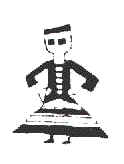|
|
Since middle ages, villagers of Daghistan were very well-known of their skillfulness and profession in producing various crafts. Absolute development of weaving skills, high quality of wool and apply of natural elements in dyeing, have created splendid collection of textures in this region.
In Daghistan kilim is called "Davaghin"; most of kilims are the same in composition, size and color. These hand-woven have powerful designs and composition of colors and mostly used as wall-hanging.
Cotton rings could still be seen on some of kilims. Large geometric and imaginary motifs, which are known as "Rakzal", and is the symbol of dragon, are used in Daghistan kilims.
Another abstract design, which is also a symbol of dragon, is seen in margins of some kilims that is decorated by trees, birds and human motifs. This composition is in light colors and smaller than other compositions.
Today, salesmen call these two types of hand-woven "Avar": Origin and parentage of "Avar" tribe people are not determined yet. Some believe that they have lived in some parts of Caucasia in the middle of the 6th century. Avar language is spoken in western and central Daghistan.
Kilims are woven in shape of runners and mostly in blue and red colors. In Daghistan, two woolen warps wind together and this makes these hand-woven different.
Design: Pair shapes
Size and feature: Long and narrow
Materials: Thick applied wool
Texture: Slit weave
Colors: Background in dark and light blue, hardly dark green, brown, orange and cream
Fringes: Spun
Selvages: Plain

|
|

